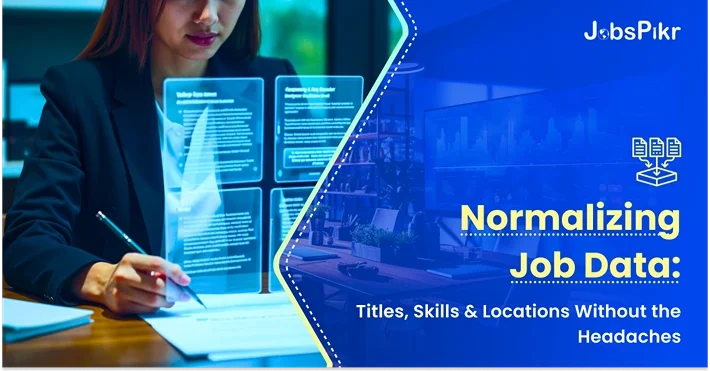- What Is Data Normalisation?
- The End-to-End Normalisation Pipeline
- See how normalisation transforms messy job data.
- Normalising Job Titles: From Chaos to Canonical
- Normalising Skills: From Keyword Soup to Structured Knowledge
- Normalising Locations: From Geographic Chaos to Structured Hierarchies
- Architecture & Operations: Building for Scale and Reliability
- Advanced ML Differentiation: Beyond Basic Matching
- Measurement & QA: What to Track for Success
- Implementation Standards & Recommendations
- Real-World Impact: Case Studies in Practice
- Your Normalisation Checklist: Getting Started
- Transform Your Talent Data Today
- See how normalisation transforms messy job data.
- FAQs
Picture this: your talent analytics dashboard shows 18,400 unique job titles for what should be 900 distinct roles. “Senior Software Engineer,” “Sr. SWE (ML),” “S/W Eng III,” and “Lead Software Developer – Machine Learning” all represent similar positions, but your system treats them as completely different entities. Meanwhile, skills data is equally chaotic—”PostgreSQL,” “Postgres,” and “psql” scatter across your database, and location fields range from “NYC” to “New York, NY, USA” to “Remote – United States.”
This isn’t just a data quality problem, it’s a business intelligence crisis. Organizations waste an average of $12.9M annually on poor data quality, with employees spending 27% of their time dealing with data issues. For talent teams, this chaos manifests in fragmented analytics where role comparisons become impossible, failed automation as candidate-job matching algorithms break down with inconsistent representations, and countless hours of analyst time spent cleaning data instead of generating insights. The downstream impact ripples through every workforce decision, from territory planning to compensation benchmarking.
The solution lies in entity normalisation. Meaning, systematically mapping messy, user-generated strings to clean, canonical values. Unlike database normalisation (which focuses on schema design) or ML feature scaling (which transforms numerical data), entity normalisation tackles the fundamental challenge of standardizing real-world text data into structured, queryable formats.
Ready to take the headaches out of job data?
What Is Data Normalisation?
The term “data normalisation” means different things to different teams, creating unnecessary confusion in technical discussions. Here are the types:
- Database Normalisation focuses on eliminating redundancy through normal forms (1NF, 2NF, 3NF). This approach standardizes data formats and removes redundancies, delivering consistent, structured, and easily queryable data within databases. While foundational for schema design, it doesn’t solve the entity-level chaos in talent data.
- Feature Normalisation in machine learning involves scaling techniques like min-max normalisation or z-score standardization. Normalisation scales data to a specific range, often between 0 and 1, while standardization adjusts data to have a mean of 0 and standard deviation of 1. This is crucial for ML model performance but operates on numerical features, not categorical entities.
- Entity Normalisation (our focus) maps free-text entries to controlled vocabularies and standardized codes. This enables consistent analytics, reliable enrichment, and scalable automation across talent workflows.
The End-to-End Normalisation Pipeline
Modern job data normalisation requires a hybrid approach combining rule-based precision with ML-powered flexibility. The complete pipeline ingests chaotic data from job postings, resumes, HRIS exports, and applicant tracking systems—each with their own formatting quirks and inconsistencies.
- The preprocessing foundation starts with text standardization through Unicode normalisation, case folding, and whitespace trimming. Company-specific cleaning strips organizational prefixes (transforming “ACME Corp Senior Engineer” into simply “Senior Engineer”), while abbreviation expansion handles common HR shorthand like converting “SW” to “Software.” Character transliteration ensures international characters don’t break the matching process.
- The speed layer rapidly identifies potential matches through dictionary lookups for exact matches against known canonical terms, fuzzy matching algorithms like Jaro-Winkler and Levenshtein for near-matches, regex patterns that extract seniority levels and employment types, and N-gram analysis to capture partial matches.
- The accuracy layer leverages recent research showing multi-aspect embeddings combining semantic, graph, and syntactic signals achieve significant improvements in job title normalisation tasks. This sophisticated ranking system uses semantic embeddings from SBERT/MPNet models to capture contextual similarity, analyzes co-occurrence signals where skills-to-titles relationships inform disambiguation, applies graph embeddings that leverage career progression patterns, and incorporates industry priors with regional weights.
Rather than forcing every input into a predefined bucket, modern systems implement confidence-aware decision making. They only make assignments above statistical certainty levels, route uncertain cases to human reviewers through abstention logic, present ranked suggestions for operational review, and maintain complete audit trails showing decision rationale through provenance tracking.
See how normalisation transforms messy job data.
Schedule a quick demo and we’ll show you how standardized titles, skills, and locations make workforce analytics, matching, and planning accurate and effortless.
Normalising Job Titles: From Chaos to Canonical
Job title normalisation delivers the highest ROI in talent data workflows because titles drive role analysis, compensation benchmarking, and career pathing insights. The challenge lies in choosing the right target taxonomy and implementing context-aware matching.
- Taxonomy selection presents three main approaches. External standards like ONET-SOCa provide 923 occupation codes with detailed descriptions, enabling external benchmarking and regulatory compliance. Vendor libraries from companies offer proprietary taxonomies trained on millions of job postings, providing better coverage of emerging roles and market variations. Many organizations adopt a hybrid approach, layering compact custom taxonomies over ONET foundations to capture internal role distinctions while maintaining external compatibility.
- Modern job title normalisation extends far beyond simple string matching through sophisticated feature engineering. The system extracts seniority levels (Junior, Mid-level, Senior, Principal, Director) using pattern recognition, distinguishes individual contributor roles from management positions through linguistic cues, identifies functional areas like Engineering or Marketing through skills co-occurrence, flags employment types such as contract or internship positions, and most critically, uses contextual disambiguation by analyzing job descriptions and required skills to resolve ambiguous titles—distinguishing between “Architect” at a construction company versus a tech startup.
- The foundation starts with rules-first mapping for common variations, where a single rule can normalise hundreds of variants: “Senior Software Engineer” becomes the canonical form for “Sr Software Engineer,” “Sr. SWE,” “Senior SDE,” and “Lead Software Developer.” This deterministic approach handles the majority of cases quickly and reliably.
- Embedding-assisted discovery tackles the long tail of unusual titles. The JAMES model demonstrates how multi-aspect graph embeddings achieve 10.06% improvement in Precision@10 for job title normalisation. The process generates embeddings for unmapped titles, applies HDBSCAN clustering to group semantically similar ones, labels clusters using LLM assistance and human verification, then converts high-confidence clusters into normalisation rules.
- An active learning loop continuously improves coverage by prioritizing high-volume low-confidence cases, focusing on emerging roles and industry variants, and building golden datasets for regression testing.
- Quality assurance requires comprehensive measurement across multiple dimensions. Coverage metrics track what percentage of input titles get successfully normalised versus requiring human review. Accuracy measures maintain precision and recall against curated golden sets, measured separately by industry vertical. Consistency checks monitor for regression errors when adding new rules, ensuring “Senior Software Engineer” doesn’t accidentally map to “Marketing Manager.” Most importantly, business impact tracking measures cardinality reduction (like collapsing 18,400 raw titles to 900 canonical ones), analyst time saved, and downstream analytics quality improvements.
Normalising Skills: From Keyword Soup to Structured Knowledge
Skills normalisation enables lateral mobility analysis, curriculum mapping, and competency-based matching, but requires different approaches than title standardization. The key lies in leveraging maintained frameworks while building robust extraction pipelines. Maintained skills frameworks provide the foundation for consistent mapping.
The European ESCO framework offers multilingual skills mapping with stronger European coverage. Many organizations adopt hybrid approaches, mapping internal skills to external frameworks while maintaining custom categories for proprietary tools and processes.
Extraction and Canonicalization Pipeline
Multi-source Extraction: Pull skills from job descriptions, resumes, learning management systems, and performance reviews using:
- Named Entity Recognition (NER): Identify skill mentions in free text
- Term matching: Handle multi-word expressions like “Machine Learning Operations” or “Supply Chain Management”
- Context-aware filtering: Distinguish between “R programming” and “R&D” based on surrounding text
Synonymy Resolution: Address the proliferation of tool variants:
- “PostgreSQL” ← [“Postgres”, “psql”, “PostGres”, “PostgreSQL DB”]
- “React.js” ← [“React”, “ReactJS”, “React JavaScript”, “React Framework”]
Polysemy Handling: Disambiguate terms with multiple meanings—”Python” (programming language vs. snake), “Java” (programming vs. geography), “R” (statistics vs. rating systems).
Importance Weighting: Use TF-IDF analysis and embedding-based salience scoring to prioritize core competencies over generic skills like “communication” or “teamwork.”
3. Family-Level Mapping and Hierarchies
Organize individual skills into coherent families enabling roll-up analysis:
- Technology Stacks: Group “React,” “Node.js,” “JavaScript” under “Frontend Development”
- Domain Expertise: Cluster “Financial Modeling,” “Risk Management,” “Portfolio Analysis” under “Investment Banking”
- Soft Skills: Aggregate communication variants into standardized competency categories
4. Continuous Quality Monitoring
- Precision Analysis: Measure how often the top K extracted skills for a job/candidate actually represent their core competencies.
- False Positive Detection: Monitor for extraction errors—”Excel” shouldn’t be tagged when someone mentions “excelling at customer service.”
- Drift Monitoring: Track emergence of new technologies and frameworks requiring taxonomy updates.
- Cross-validation: Compare skill extraction across different sources (resume vs. LinkedIn profile vs. job description) to identify systematic biases.
Ready to take the headaches out of job data?
Normalising Locations: From Geographic Chaos to Structured Hierarchies
Location normalisation enables territory planning, compensation analysis, and remote work policy implementation but geographic data presents unique challenges.
1. Target Representation Standards
Coordinates + Metadata: Every location should resolve to:
- Latitude/longitude: Enables radius-based search and visualization
- Canonical place name: Human-readable identifier
- Administrative hierarchy: City → State/Province → Country
- Standard codes: ISO-3166 country codes, optional UN M.49 regions
- GeoNames ID: Stable identifier for deduplication and external joins
Remote Work Handling: Structure remote positions with:
- Governing jurisdiction: Legal/tax implications for employment
- Time zone preferences: For coordination and scheduling
- Travel requirements: Percentage on-site expectations
2. Geocoding and Disambiguation Logic
Text Preprocessing: Clean location strings handling Unicode characters, punctuation variations, and common abbreviations:
- “NYC, NY” → “New York City, New York, United States”
- “Bengaluru, KA, IN” → “Bangalore, Karnataka, India”
Ambiguity Resolution: Handle cases like “Springfield” (appears in 30+ US states):
- Context clues: Use company headquarters or regional posting patterns
- Population priors: Weight toward larger cities in ambiguous cases
- Country/region hints: Apply geographic constraints based on job requirements
Confidence Scoring: Rate geocoding certainty and route low-confidence cases for human review.
3. Metro Area and Market Aggregation
Talent Market Definition: Group cities into coherent hiring markets:
- San Francisco Bay Area: SF + Oakland + San Jose + Peninsula cities
- Greater Boston: Boston + Cambridge + surrounding suburbs
- National Capital Region: DC + Northern Virginia + Maryland suburbs
Compensation Zone Mapping: Align with HR compensation bands and cost-of-living adjustments.
4. Geographic Quality Assurance
- Success Rate Monitoring: Track percentage of input locations successfully geocoded with high confidence.
- Coordinate Validation: Flag impossible coordinates, timezone mismatches, and country inconsistencies.
- Hierarchy Completeness: Ensure city-state-country relationships are properly populated.
- Boundary Edge Cases: Handle locations near borders, disputed territories, and administrative changes.
Architecture & Operations: Building for Scale and Reliability
Enterprise job data normalisation requires robust operational practices supporting both batch processing and real-time applications.
Infrastructure Patterns
Batch + Streaming Hybrid:
- Nightly backfills: Process accumulated job postings, resume updates, and HRIS changes
- Streaming hooks: Handle real-time candidate applications and urgent job postings
- Idempotent processing: Ensure repeated runs produce consistent results
Feature Store Integration: Maintain pre-computed embeddings, lookup tables, and cached similarity scores for sub-second response times.
Provenance Logging: Track complete audit trails:
- Input data: Raw strings and metadata context
- Processing steps: Rules triggered, candidates generated, scores computed
- Human decisions: Reviewer assignments and approval rationale
- Output mappings: Final canonical assignments with confidence scores
Taxonomy Management and Versioning
External Dependencies: Skills libraries, occupation codes, and geographic databases update on independent schedules:
- O*NET-SOC: Major revisions every 5-10 years with annual supplements
- GeoNames: Continuous updates for administrative changes
Version Control: Treat taxonomies as code with proper change management:
- Semantic versioning: Track breaking versus additive changes
- Migration scripts: Handle canonical ID changes and deprecations
- Rollback procedures: Quick reversion for problematic updates
Re-normalisation Triggers: Automatically re-process data when taxonomy changes affect significant entity populations.
Human-in-the-Loop Workflows
Active Learning Queues: Prioritize human review cases by:
- Business impact: High-volume entities affecting many records
- Uncertainty scores: Low-confidence assignments requiring expert judgment
- Novel patterns: Previously unseen title/skill/location combinations
- Error escalations: Cases flagged by downstream quality monitors
Reviewer SLAs: Establish turnaround time expectations and workload distribution.
Quality Feedback Loops: Route reviewer decisions back into model training and rule refinement.
Advanced ML Differentiation: Beyond Basic Matching
Organizations achieving competitive advantage in talent analytics implement sophisticated ML workflows that go beyond simple string matching.
Multi-Signal Fusion Architecture
Cross-Modal Enhancement: Use job descriptions to improve title normalisation accuracy:
- Skills-Title Co-attention: “Machine Learning” + “Python” skills boost confidence in “ML Engineer” assignments
- Industry Context: “Analyst” in financial services versus healthcare requires different treatment
- Company Size Signals: Startup “VP” roles map differently than Fortune 500 equivalents
Graph-Based Reasoning: Research demonstrates that incorporating career transition graphs improves normalisation accuracy:
- Progression Patterns: “Junior Developer” → “Software Engineer” → “Senior SDE” transitions validate title hierarchies
- Lateral Movement: Skills that commonly transfer between roles inform similarity calculations
- Industry Mobility: Cross-sector career patterns reveal role equivalencies
Confidence-Calibrated Outputs
Uncertainty Quantification: Rather than forcing binary classifications, provide probability distributions:
- Top-N Suggestions: Present multiple candidates with confidence scores for operational review
- Abstention Thresholds: Configure business-specific cutoffs balancing automation versus accuracy
- Escalation Routing: Automatically queue uncertain cases for expert annotation
Active Learning Integration: Continuously improve model performance through strategic human feedback:
- Query Selection: Identify samples that would most improve model performance if labeled
- Cold Start Handling: Bootstrap performance in new industries or regions with minimal training data
- Drift Detection: Monitor for concept drift requiring model retraining
Performance Benchmarking
Baseline Comparisons: Demonstrate ML workflow advantages over rule-based approaches:
- Precision/Recall Gains: 15-25% improvement typical in complex domains
- Coverage Expansion: Handle long-tail cases that rules miss
- Maintenance Reduction: Fewer manual rule updates as models adapt
Business Metrics: Connect technical improvements to operational outcomes:
- Analyst Time Saved: Measure reduction in manual data cleaning effort
- Match Rate Improvement: Track increase in successful candidate-job pairings
- Time-to-Insight: Faster analytics delivery through cleaner foundational data
Measurement & QA: What to Track for Success
Effective job data normalisation requires comprehensive monitoring across technical performance and business impact dimensions.
Technical Performance Metrics
By Entity Type:
Job Titles:
- Precision/Recall/F1: Against curated golden datasets, measured separately by industry vertical
- Cluster Purity: When using unsupervised discovery, measure semantic coherence within normalised groups
- Seniority Accuracy: Correct parsing of career levels across different title formats
- Abstention Rate: Percentage routed to human review (target: 5-10% for mature systems)
Skills:
- Precision@K: Accuracy of top K extracted skills per job/candidate profile
- Synonym Resolution: Successfully merged variant representations
- Polysemy Error Rate: Incorrect disambiguation of ambiguous terms
- Coverage Drift: Detection of new skills requiring taxonomy updates
Locations:
- Geocoding Success: Percentage resolved to coordinates with high confidence (target: >95%)
- Ambiguity Rate: Cases requiring human disambiguation (target: <5%)
- Hierarchy Completeness: City-state-country fields properly populated
- Boundary Accuracy: Coordinate-administrative region consistency
Pipeline-Level KPIs
Normalisation Coverage: Percentage of input records successfully processed across all entity types.
Deduplication Impact: Cardinality reduction achieved—typical results show 80-90% reduction in unique entities.
Processing Latency: Response time for real-time normalisation requests (target: <200ms for cached lookups).
Reprocessing Volume: Records requiring re-normalisation when taxonomies update.
Business Impact Measurement
Downstream Analytics Quality:
- Dashboard Consistency: Reduction in “unknown” or “other” categories
- Benchmark Reliability: Improved accuracy in role comparison and compensation analysis
- Trend Detection: Earlier identification of emerging skills and role patterns
Operational Efficiency:
- Manual Review Reduction: Analyst time savings from automated normalisation
- Matching Algorithm Performance: Improvement in candidate-job relevance scores
- Territory Planning Accuracy: Better geographic analysis for sales and recruiting
Revenue Impact:
- Time-to-Fill Reduction: Faster hiring through improved candidate discovery
- Client Analytics Value: Enhanced workforce intelligence product capabilities
- Compliance Automation: Reduced manual effort in regulatory reporting
Implementation Standards & Recommendations
Proven Taxonomy Choices
Occupations: O*NET-SOC provides the strongest foundation for US-based organizations, with 923 detailed occupation profiles enabling external benchmarking and government data integration.
Geography: Combine ISO-3166 country codes with GeoNames IDs for stable, internationally recognized location references.
Technical Architecture Patterns
ETL Tool Integration: Organizations using Talend, Qlik, or similar platforms should leverage built-in normalisation components as starting points, then extend with custom ML workflows.
Semantic Model Inspiration: Certain approaches establish shared schemas enabling consistent analysis across different data sources and teams.
API-First Design: Expose normalisation capabilities through REST APIs enabling integration with existing HR tech stacks and analytics platforms.
Quality Assurance Framework
Golden Dataset Creation: Build industry-specific test sets with 1,000-5,000 examples per entity type, reviewed by domain experts.
Regression Testing: Automated validation suites preventing quality degradation as systems evolve.
Performance Monitoring: Real-time dashboards tracking success rates, confidence distributions, and business impact metrics.
Real-World Impact: Case Studies in Practice
- Title Sprawl Resolution: A Fortune 500 technology company collapsed 18,400 unique job titles to 1,100 canonical roles using embedding clustering + rule refinement + reviewer loops. Results: 94% precision, 7% abstention rate, 60% reduction in analyst time spent on role analysis.
- Skills Standardization Success: A global consulting firm mapped 85% of extracted skill mentions to canonical IDs, eliminating generic skill noise and improving job-candidate similarity scores by 23%. The structured skills data enabled new curriculum mapping and upskilling recommendation capabilities.
- Geographic Consistency Achievement: A distributed workforce company achieved 96% single-candidate geocoding success rate, with 4% routed for human review. Timezone mismatch alerts prevented 150+ scheduling conflicts monthly, and standardized location hierarchies enabled territory-based analytics.
Your Normalisation Checklist: Getting Started
1. Define Your Targets
- Titles: Choose O*NET-SOC for external benchmarking or vendor taxonomies for coverage
- Skills: Adopt vendor library or ESCO for European markets
- Geography: Implement ISO-3166 + GeoNames ID standard
2. Build Your Hybrid Pipeline
- Preprocessing: Unicode normalisation, case folding, abbreviation expansion
- Fast layer: Dictionary lookups, fuzzy matching, regex patterns
- Accurate layer: Embedding-based candidate ranking with confidence scores
- Decision logic: Threshold-based assignments with abstention for low-confidence cases
3. Implement QA & Monitoring
- Golden datasets: 1,000-5,000 examples per entity type for validation
- Performance tracking: Precision/recall, coverage, abstention rates
- Business metrics: Cardinality reduction, analyst time saved, downstream quality
- Drift detection: Monitor for new entities requiring taxonomy updates
4. Version Everything
- Taxonomies: Treat as versioned datasets with migration procedures
- Models: Track training data, hyperparameters, and performance benchmarks
- Rules: Document decision logic and maintain regression test suites
- Outputs: Enable rollback and re-normalisation when standards change
5. Prove Business Impact
- Technical wins: Report precision improvements over baseline approaches
- Operational gains: Document analyst time savings and process automation
- Strategic value: Measure analytics quality improvements and new capabilities enabled
- ROI calculation: Connect data quality improvements to business outcomes
Transform Your Talent Data Today
Clean, standardized job entities form the foundation for every advanced analytics workflow—from predictive hiring models to skills gap analysis to compensation benchmarking. The techniques outlined above represent proven approaches for eliminating data chaos while maintaining the flexibility needed for evolving business requirements. The hybrid rules + ML methodology delivers both the accuracy executives demand and the auditability compliance teams require. No more “black box” anxiety about how your normalisation decisions get made.
See how normalisation transforms messy job data.
Schedule a quick demo and we’ll show you how standardized titles, skills, and locations make workforce analytics, matching, and planning accurate and effortless.
FAQs
1. What do you mean by data normalisation?
Data normalisation is the process of standardizing messy or inconsistent data into clean, structured, and comparable formats. In databases, it reduces redundancy and organizes data efficiently. In analytics and talent data, it means mapping free-text fields (like job titles, skills, or locations) to canonical values so reporting, matching, and ML models work correctly.
2. What is 1NF, 2NF, and 3NF?
1NF (First Normal Form): Each table cell holds a single value, and every record is unique.
2NF (Second Normal Form): Builds on 1NF by ensuring non-key attributes depend entirely on the primary key (no partial dependencies).
3NF (Third Normal Form): Builds on 2NF by ensuring attributes depend only on the primary key, not on other non-key attributes (removes transitive dependencies).
3. What are the five rules of data normalisation?
The five common rules (often aligned with normal forms) are:
Eliminate repeating groups (1NF).
Eliminate partial key dependencies (2NF).
Eliminate transitive dependencies (3NF).
Ensure no multi-valued dependencies (4NF).
Ensure no join dependencies and preserve data integrity (5NF).
4. What is min/max normalisation?
Min-max normalisation is a feature scaling technique used in machine learning. It rescales values into a fixed range—usually 0 to 1—using the formula:
(x−min)/(max−min)(x – min) / (max – min)(x−min)/(max−min).
This ensures all features contribute proportionally, preventing larger-valued attributes from dominating a model.
5. What are the three goals of normalisation?
The three main goals are:
Reduce redundancy – avoid storing the same data in multiple places.
Improve data integrity – ensure updates or changes happen consistently.
Enable efficient querying and analytics – structured, normalised data is easier to process, join, and analyze without errors.




